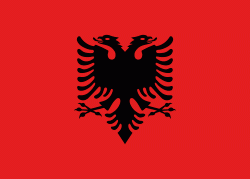Island of Zvërnec (Ishulli i Zvërnecit)
Zvërnec Island is an island within the Narta Lagoon in southern Albania.
The island is nearly all covered with tall pine trees and is just east of a much smaller island. It is 430m in length and has a maximum width of 300m. Zvërnec Island is connected to the mainland by a 270m long wooden bridge.
The island is a tourist attraction because it contains the well preserved 13th-14th century Byzantine Zvërnec Monastery. Near the island lies the village that bears the same name. The island has an area about 9 hectares.
The island is nearly all covered with tall pine trees and is just east of a much smaller island. It is 430m in length and has a maximum width of 300m. Zvërnec Island is connected to the mainland by a 270m long wooden bridge.
The island is a tourist attraction because it contains the well preserved 13th-14th century Byzantine Zvërnec Monastery. Near the island lies the village that bears the same name. The island has an area about 9 hectares.
Map - Island of Zvërnec (Ishulli i Zvërnecit)
Map
Country - Albania
 |
 |
| Flag of Albania | |
Albania has been inhabited by different civilisations over time, such as the Illyrians, Thracians, Ancient Greeks, Romans, Byzantines, Venetians, and Ottomans. The Albanians established the autonomous Principality of Arbër in the 12th century. The Kingdom of Albania and Principality of Albania formed between the 13th and 14th centuries. Prior to the Ottoman conquest of Albania in the 15th century, the Albanian resistance to Ottoman expansion into Europe led by Skanderbeg won them acclaim over most of Europe. Albania remained under Ottoman rule for nearly five centuries, during which many Albanians (known as Arnauts) attained high-ranking offices in the empire, especially in the Southern Balkans and Egypt. Between the 18th and 19th centuries, cultural developments, widely attributed to Albanians having gathered both spiritual and intellectual strength, conclusively led to the Albanian Renaissance. After the defeat of the Ottomans in the Balkan Wars, the modern nation state of Albania declared independence in 1912. In the 20th century, the Kingdom of Albania was invaded by Italy, which formed Greater Albania before becoming a protectorate of Nazi Germany. Enver Hoxha formed the People's Socialist Republic of Albania after World War II, modeled under the terms of Hoxhaism. The Revolutions of 1991 concluded the fall of communism in Albania and eventually the establishment of the current Republic of Albania.
Currency / Language
| ISO | Currency | Symbol | Significant figures |
|---|---|---|---|
| ALL | Albanian lek | L | 2 |
| ISO | Language |
|---|---|
| SQ | Albanian language |
| EL | Greek language |















